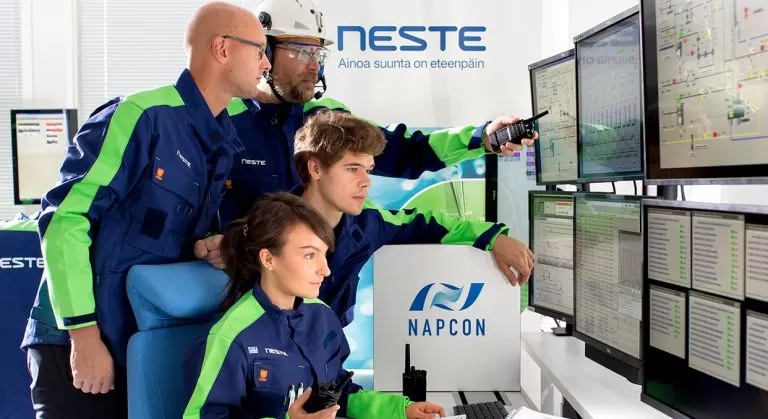Future Factory: How Technology Is Transforming Manufacturing

Share this blog
From advanced robotics in R&D labs to computer vision in warehouses, technology is making an impact on every step of the manufacturing process.
“Lights-out manufacturing” refers to factories that operate autonomously and require no human presence. Because they don’t need human supervision, they don’t require lighting, and can consist of several machines functioning in the dark.
While this may sound like science fiction, these kinds of factories have been a reality for more than 15 years.
The Japanese robotics maker FANUC has been operating a “lights-out” factory since 2001, where robots build other robots completely unsupervised for nearly a month at a time.
“Not only is it lights-out,” said FANUC VP Gary Zywiol, “we turn off the air conditioning and heat too.”
To imagine a world where robots do all the physical work, one simply needs to look at the most ambitious and technology-laden factories of today.
In June 2018, the Chinese e-commerce giant JD.com unveiled a fully automated storage and shipping facility in Shanghai.
The factory is outfitted with twenty industrial robots that can pick, pack, and transfer packages with no human presence or oversight.
Without robots, it would take as many as 500 workers to fully staff this 40K square foot warehouse — instead, the factory requires only five technicians to service the machines and keep them working.
As industrial technology grows increasingly pervasive, this wave of automation and digitization is being labelled “Industry 4.0,” as in the fourth industrial revolution.
So, what does the future of factories hold?
To answer this, we took a deep dive into 8 different steps of the manufacturing process, to see how they are starting to change:
- Product R&D: A look at how platforms are democratizing R&D talent, the ways AI is helping materials science, and how the drafting board of tomorrow could be an AR or VR headset.
- Resource Planning & Sourcing: On-demand decentralized manufacturing and blockchain projects are working on the complexities of integrating suppliers.
- Operations Technology Monitoring & Machine Data: A look at the IT stack and platforms powering future factories. First, factories will get basic digitization, and further along we’ll see greater predictive power.
- Labor Augmentation & Management: AR, wearables, and exoskeletons are augmenting human capabilities on the factory floor.
- Machining, Production & Assembly: Modular equipment and custom machines like 3D printers are enabling manufacturers to handle greater demand for variety.
- Quality Assurance (QA): A look at how computer vision will find imperfections, and how software and blockchain tech will more quickly be able to identify problems (and implement recalls).
- Warehousing: New warehouse demand could bring “lights-out” warehouses even faster than an unmanned factory, with the help of robotics and vision tracking.
- Transport & Supply Chain Management: Telematics, IoT, and autonomous vehicles will bring greater efficiency and granularity for manufacturers delivering their products.
Credits: CB Insights
Get in Touch
Related Blogs

The 5 FinTech Product Engineering Trends Quietly Reshaping Global Finance

Bridging the Gap Between Innovation and Measurable Performance in the Banking Industry

Cloud at the Heart of Digital Manufacturing

Agile Methodologies in Retail Product Development: Flexibility and Responsiveness to Market Changes

The Nordic AI Advantage: Operations That Actually Work

Social Commerce, Mobile Commerce & Smart Commerce: The New Triad of Digital Growth

Staying Ahead in the AI Search Era: How GEO Complements Traditional SEO

CIOs, It’s Time to Lead AI in Healthcare—Not Just Watch It

Balancing Feature Development with Platform Enhancement: A Strategic Imperative

Managing IT Costs Effectively: A Strategic Approach to Balancing Growth and Efficiency

The Hidden Complexity of Scaling Cloud Operations: What Most Strategies Miss

Managing Technical Debt: Balancing Innovation with Sustainability

Maintaining Development Velocity While Ensuring Quality: The Balancing Act

Navigating Financial Strategies for Global Expansion in SaaS

Precision in Complexity: Redefining Capital Allocation for Sustainable Growth

Beyond Silos: Rethinking Cross-Functional Collaboration for Scalable Product Development

Simplifying Global Expansion: The Power of One Strategic Partner

The Unfinished Symphony of Digital Transformation: From Strategy to Execution

Beyond Traditional Process Intelligence: Integrating Emerging Technologies for a Competitive Edge

Tekninen Velka – Kuinka Se Haittaa Kasvua ja Miten Sen Saa Hallintaan?

A Deep Dive into Product Engineering: Process, Roles, and Best Practices

What is Cyber Resilience? An In-Depth Guide

A Comprehensive Guide to Cloud Transformation

24 Emerging Software Development Trends Transforming 2024

Is AI Secure? Addressing Cybersecurity Risks with AI

How Is Cloud Computing Transforming Sustainable Healthcare in the Nordics?

Gateway Digital is Neste Napcon’s Partner in Creating Digital Learning Environments for the Process Industry

Tuotekehitysyhteistyön avulla joustavuutta ja kustannushyötyjä – Case School Day

Petteri paju vahvistamaan Gatewayn myyntiä

Top 6 Trends Transforming Logistics and Supply Chain in 2020

Why is it Important to Hire the Right Employees to Grow your Business?

Miten IT-alan ammattilaisten vaje näkyy Suomessa?

How Can Emerging Technology Facilitate Faster Start-up Growth?

The Need For Smart Logistic Planning: Takeaways From The Suez Canal Crisis

Gateway Digital AS and Retailtech strengthen their strategic partnership

Gateway Digital and Digitate enters strategic partnership

The DACH cloud computing industry in 2021 and beyond

Why Germany is home to the most innovative Tech Startups

Dataplattform för att identifiera bilreservdelar vinner pris inom hållbarhet

AWS vs GCP vs Microsoft Azure: Everything you need to know

Ensuring a higher ROI on your Technology Investment: Here’s How

Why the future of Startups & Scaleups depends on Technology Partner

Infographic: Elevate your Business with Augmented Supply Chain

Infographic: Empowering the Digital Healthcare Ecosystem

Infographic: Why Strategic Technology Partnerships are imperative for ISVs

Infographic: How PES is Empowering the Digital Healthcare landscape

Impact of Covid 19 on the Automotive Industry

How COVID-19 is Changing the Face of Digital Healthcare

Transform your Digital Journey with Strategic Technology Partnerships

Succeed your Business with Partnerships – The New Normal for Fintech!

Supply Chain Focus Areas to Mitigate COVID-19 Disruptions

How Digital Transformation is Redefining the Healthcare Industry

Benefits of Digitising Your Product Development Process

How to Develop a New Product (From Concept to Market)

How Automotive and Technology Experts See the Future of Connected Vehicles through Future Tech 5G Service

Industry Digitization will be Top Opportunity for 5G business solutions

5G Products & Solutions in 2023 & Beyond– What Should we expect from 5g network software?

Everything You Need to Know About 5G network as a service

Cloud Companies Chase Future in Cybersecurity ‘Wild West’

The Future of Lawyers: Legal Tech, AI, Big Data And Online Courts

Why Covid-19 Could Expedite the Role of RegTech in Finance

3 Elements For Success With Mobility As A Service In Our Cities

Digitalization is Upending Global Logistics

Mastering the Duality of Digital: How Companies Withstand Disruption

iGaming Technology Trends to Watch

73% Growth and Instant Blockbusters: How Online Gaming Industry Is Blowing Up During the Pandemic

The 5 Biggest Cybersecurity Trends In 2020 Everyone Should Know About

Why Cybersecurity Is Really A Business Problem

Technological Disruption or Next Industrial Revolution?

What Will Be The Future Success Of Fashion Retail In The Digital Age

The Banking Industry Is Spending Wildly on the Latest Tech

Disruption in Manufacturing: Managing Unexpected Risks

5 Manufacturing Tech Trends Poised To Disrupt Your Business

Digital Disruption in the Manufacturing Industry

Five Ways the Internet of Things is Transforming Businesses Today

The Mobility-as-a-Service Market will Register a CAGR of Over 35% by 2023

3 Ways Every Company Should Prepare For The Internet Of Things

The Three Stages Of Cloud Transformation: Application, Network, Security

Cloud Computing Seen as Tech Haven Amid Pandemic Uncertainty

How Multi-Cloud and Digital Transformation Fit Together

8 Ways Cloud Is Transforming Business

Mixed Reality Finds Its Niche in Industrial and Business Applications

Virtual Reality is Making Marketing and Training More Effective for Businesses

What Leaders Need To Know About Augmented Reality

The 5 Biggest Virtual And Augmented Reality Trends In 2020 Everyone Should Know About

DevOps Model: The Role of Quality Assurance Redefined

Quality Engineering Has DevOps and Agile in the Driving Seat

How QA Can Support Businesses in the Journey of Digital Transformation

Quality Assurance Is Critical In Software Development And Increasingly Automated

Resolving Challenges of Auto ISVs with Fruitful Technology Partnerships

Resolve Fleet Management Challenges with Innovative Digital Automotive Solutions

Top 3 Factors Impacting Customer Satisfaction of Modern Car Buyers

Fleet Telematics Solution: Driving Great Business for Automotive Ecosystems

Top Supply Chain Tech Trends

How Artificial Intelligence Benefits Logistics and Supply Chain Management

Fleet Management in 2024 & Beyond: What Does the Future Look Like?

How to Identify a Trusted online iGaming Solutions Provider?

Mastering Enterprise Digital Transformation: Building Blocks of a Successful Strategy

Center of Excellence: Building Intelligent Solutions for the Enterprises of Tomorrow

Want to Succeed in Digital Transformation? Choose the Right Technology Partner
INDUSTRIES
PLATFORMS
SERVICES
CONSULTING
- AlvariumTM - Design Led ConsultingOpens a new window
- Digital Marketing Services
- Automotive Aftermarket
- Digital Logistics
- Remote Engineering
PROFESSIONAL SERVICES
DIGITAL
FUTURE ENGINEERING
Let's Talk
Book a Meeting
We value your privacy.
This website uses cookies and similar technologies to improve your browsing experience, measure our audience, collect useful information, and provide you with relevant content. By selecting “Accept & Continue”, you confirm that you provide your consent for the use of your information, and have read and agree to our Privacy Policy , and Terms of Use.DeclineAccept & ContinueCookie settings
Privacy Overview
| Cookie | Duration | Description |
|---|---|---|
| cookielawinfo-checkbox-analytics | 11 months | This cookie is set by GDPR Cookie Consent plugin. The cookie is used to store the user consent for the cookies in the category "Analytics". |
| cookielawinfo-checkbox-functional | 11 months | The cookie is set by GDPR cookie consent to record the user consent for the cookies in the category "Functional". |
| cookielawinfo-checkbox-necessary | 11 months | This cookie is set by GDPR Cookie Consent plugin. The cookies is used to store the user consent for the cookies in the category "Necessary". |
| cookielawinfo-checkbox-others | 11 months | This cookie is set by GDPR Cookie Consent plugin. The cookie is used to store the user consent for the cookies in the category "Other. |
| cookielawinfo-checkbox-performance | 11 months | This cookie is set by GDPR Cookie Consent plugin. The cookie is used to store the user consent for the cookies in the category "Performance". |
| viewed_cookie_policy | 11 months | The cookie is set by the GDPR Cookie Consent plugin and is used to store whether or not user has consented to the use of cookies. It does not store any personal data. |
